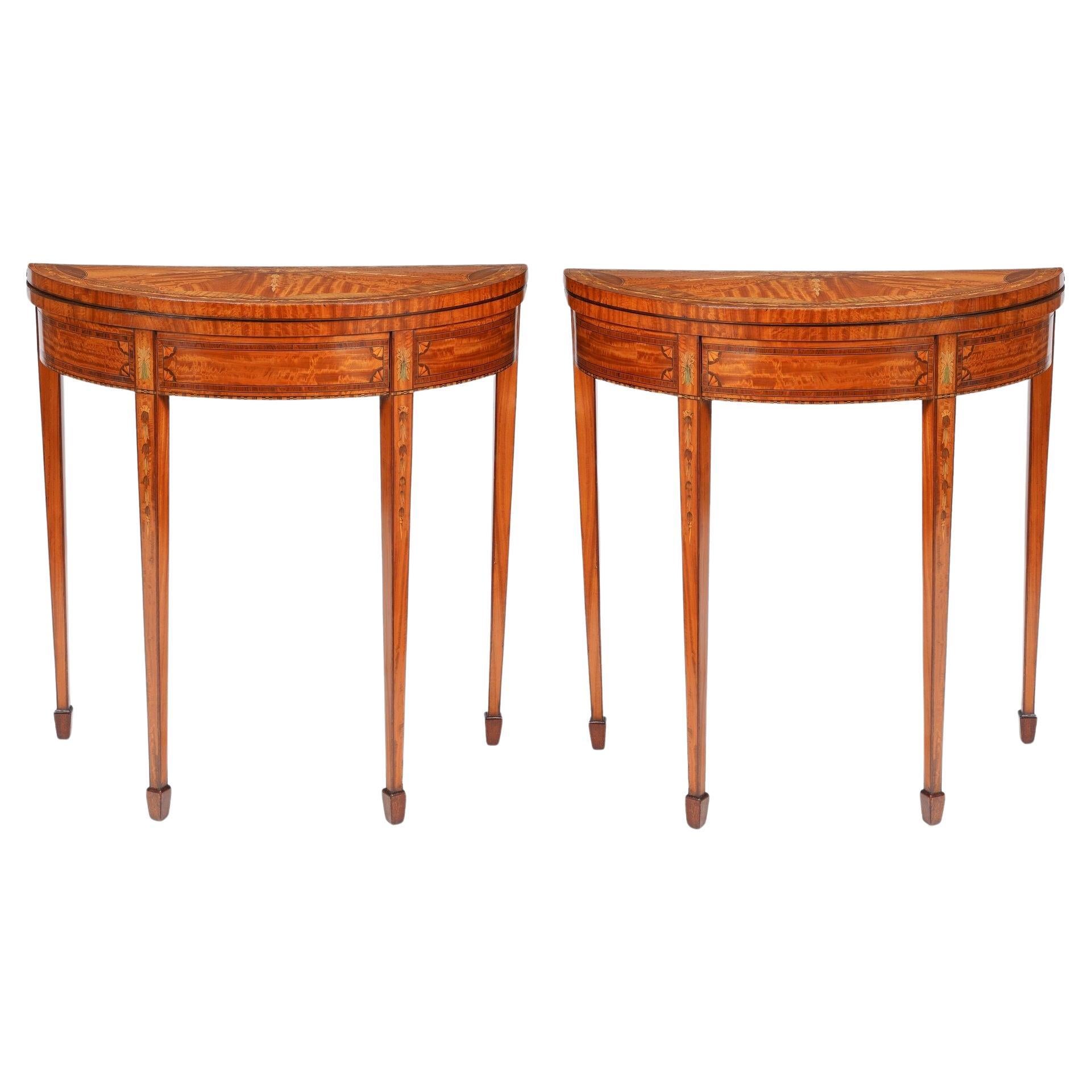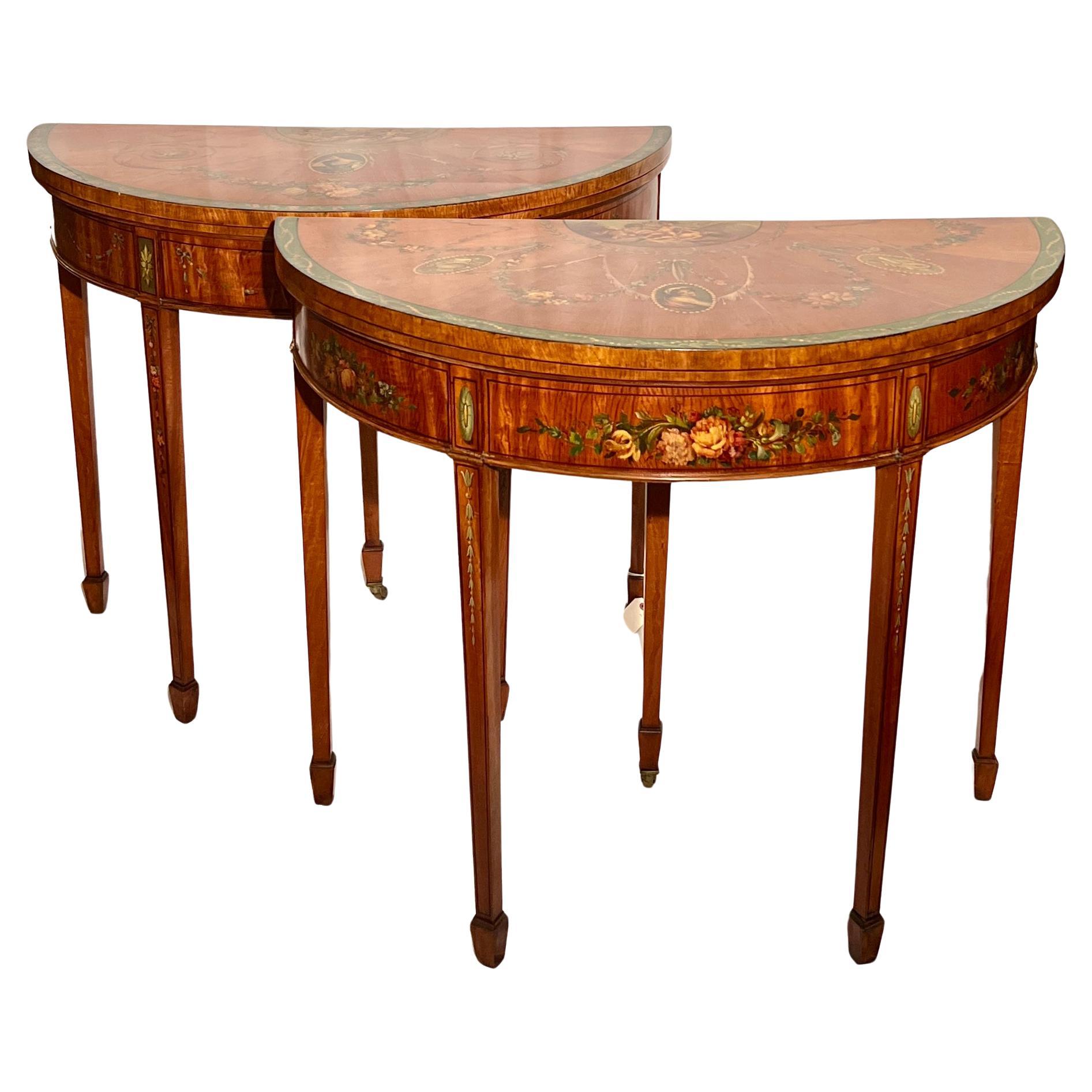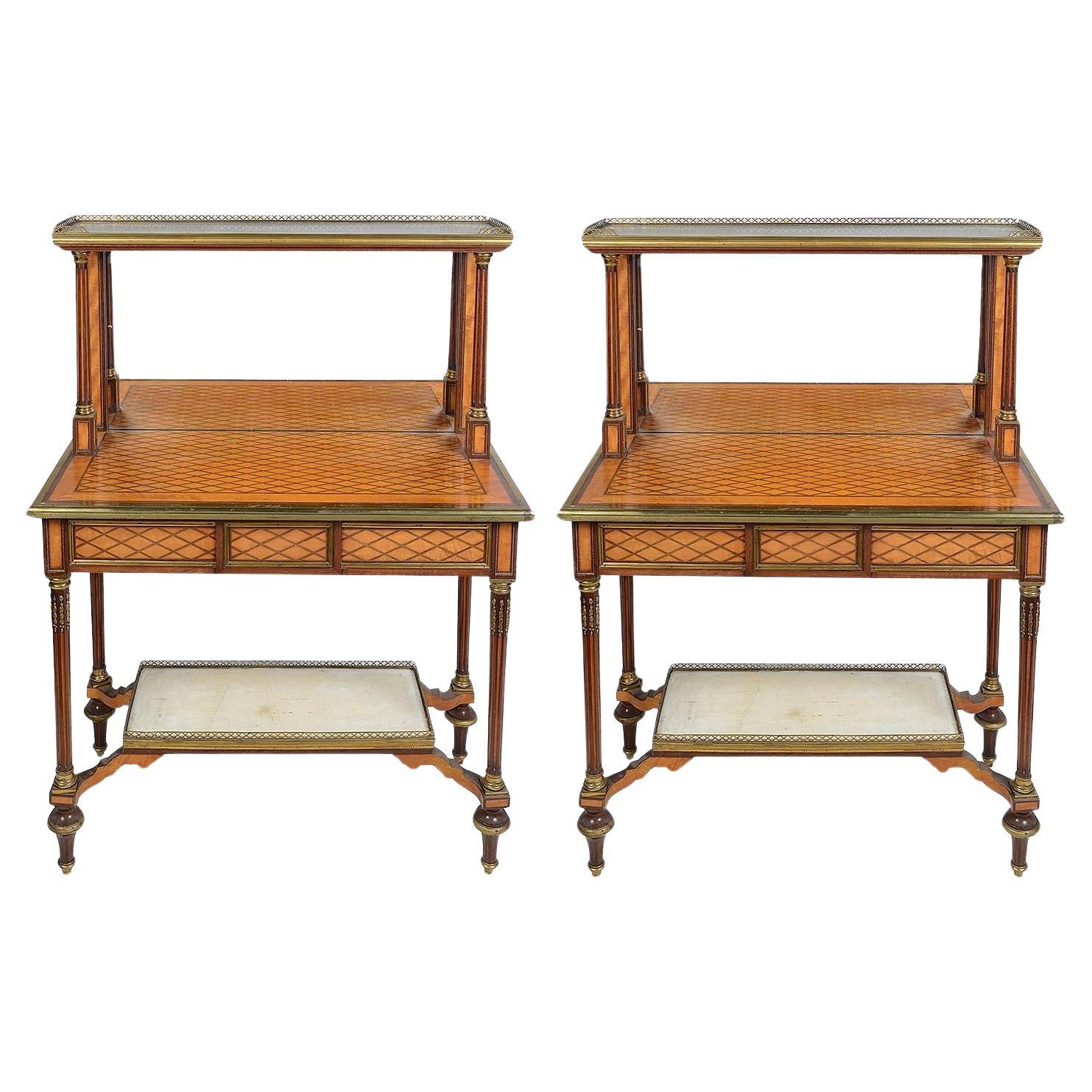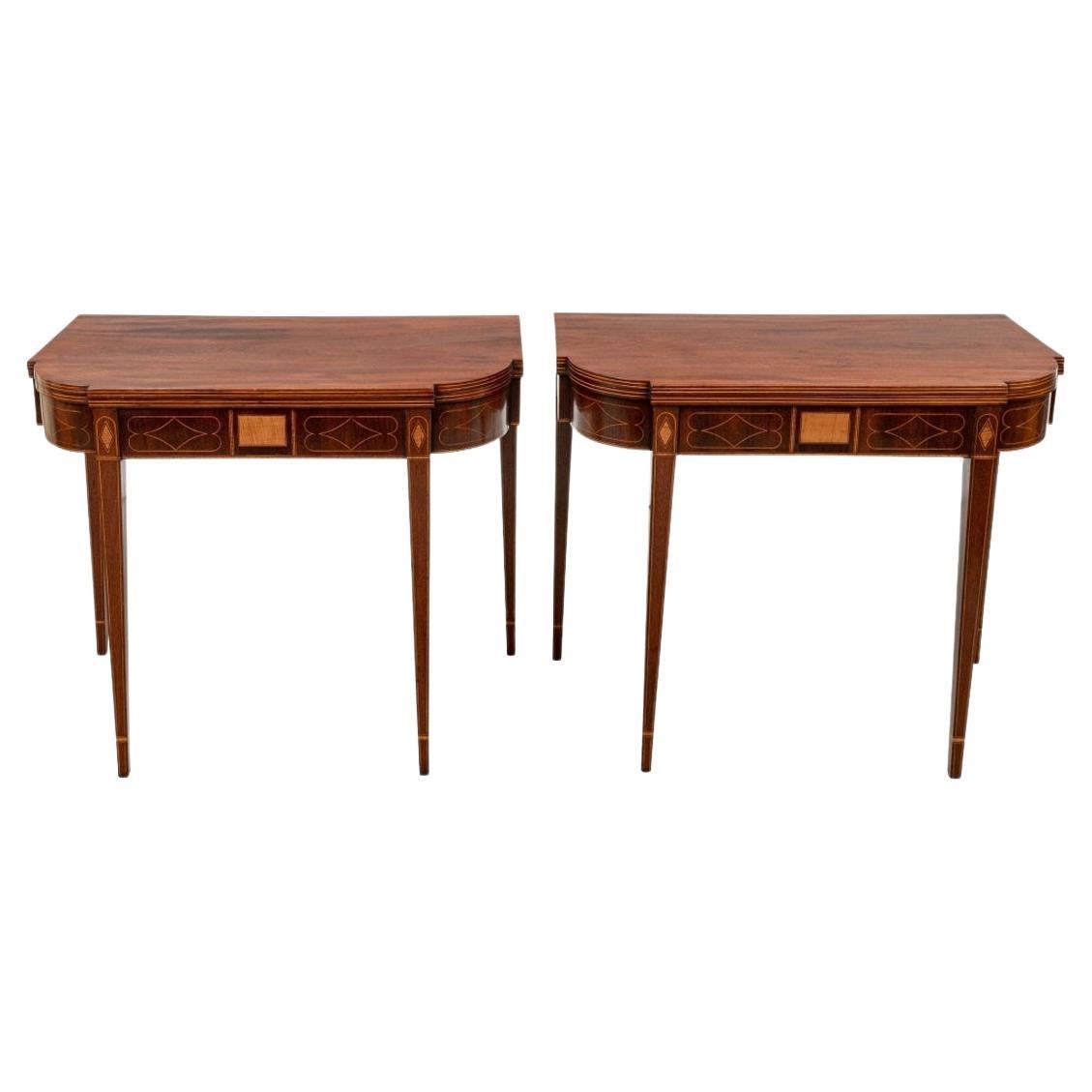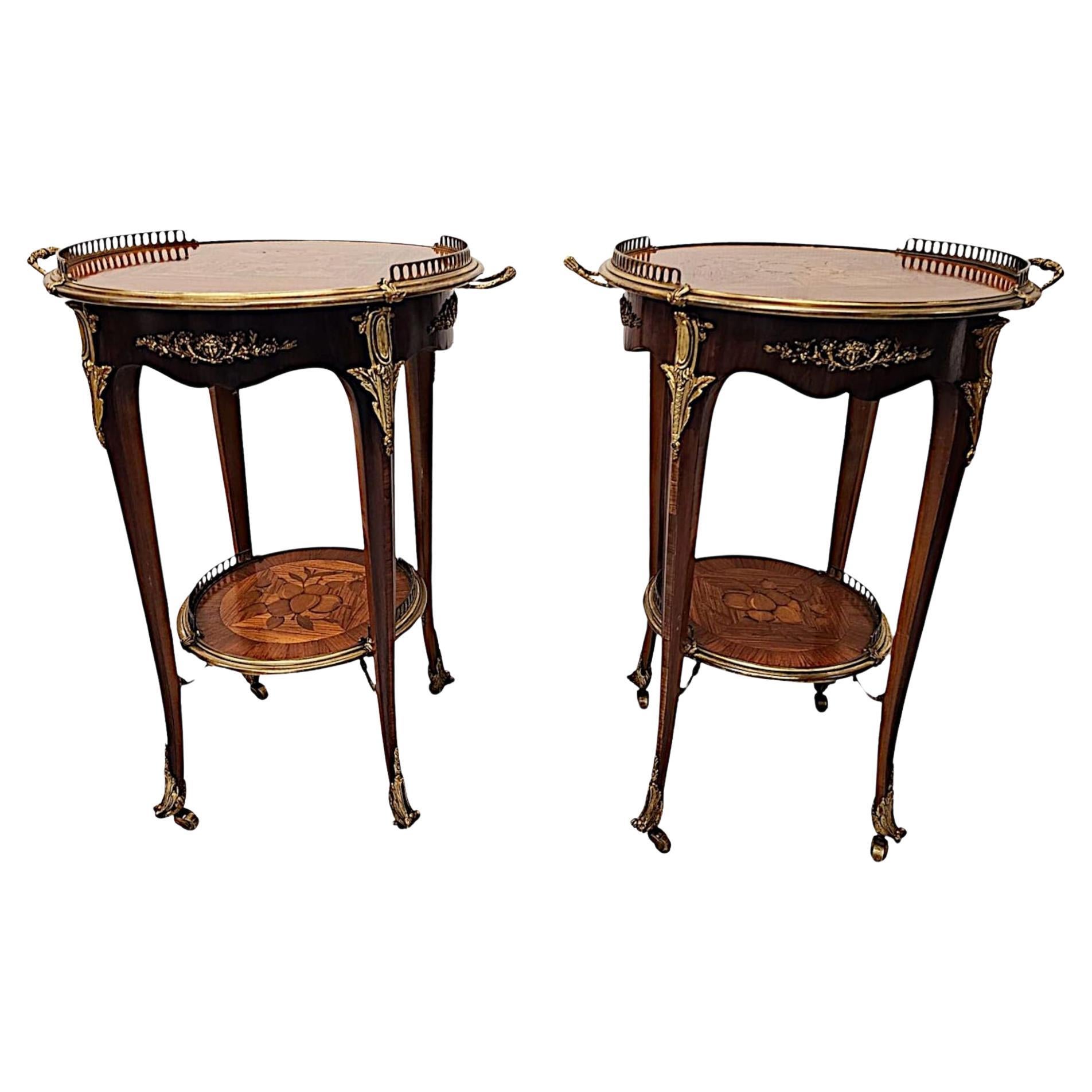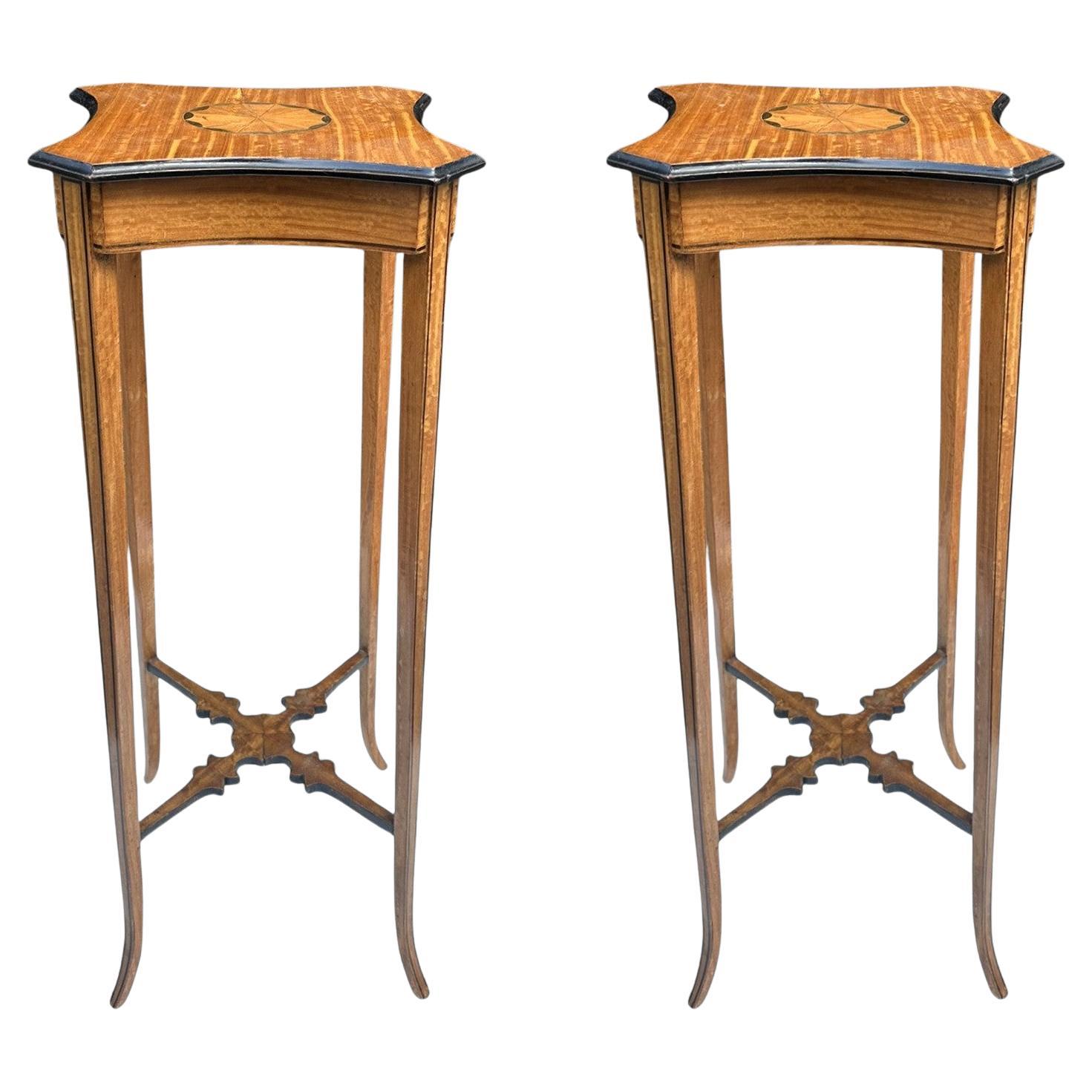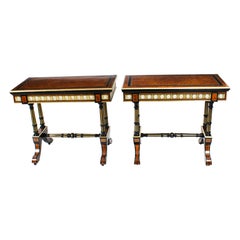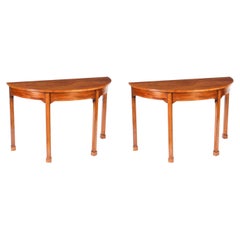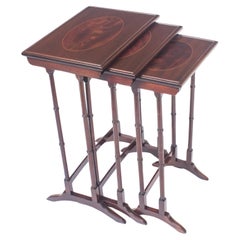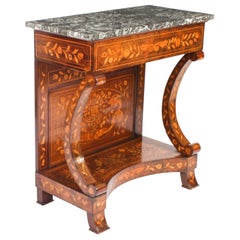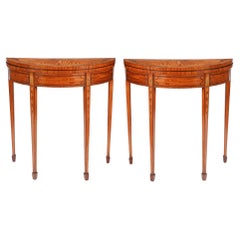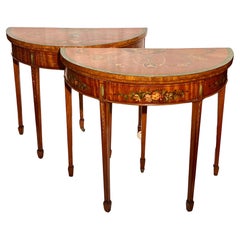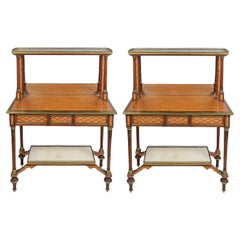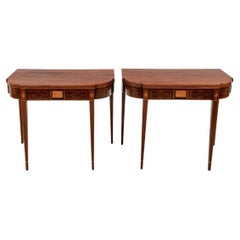Articoli simili a Antique Pair Marquetry Demi Lune Console Tables Edwards & Roberts 19th Century
Vuoi altre immagini o video?
Richiedi altre immagini o video al venditore
1 di 15
Antique Pair Marquetry Demi Lune Console Tables Edwards & Roberts 19th Century
5813,89 €per set
Informazioni sull’articolo
A fine pair of Victorian flame mahogany and marquetry demi-lune console/ bedside tables by the renowned cabinet makers Edwards and Roberts, circa 1880 in date.
Made in the manner of Thomas Sheraton they each feature a crossbanded top above a single drawer, on square tapering legs, united by a shaped undertier shelf.
The feature beautifully satin wood marquetry with classical urns, draping swags, blue bells and acanthus leaf decoration.
There is no mistaking their superb quality and very grand design, which is certain to make them a talking point in your home and stand proud in whichever room you choose to display them.
THE BOTANICAL NAME FOR THE MAHOGANY THAT THIS ITEM IS MADE OF IS SWIETENIA MACROPHYLLA AND THIS TYPE OF MAHOGANY IS NOT SUBJECT TO CITES REGULATION AND DOES NOT CONTAIN ANY RESTRICTED MATERIALS.
Condition:
In excellent condition having only been beautifully cleaned and waxed in our workshops, please see photos for confirmation.
Dimensions in cm:
Height 76 cm x Width 58 cm x Depth 30 cm
Dimensions in inches:
Height 2 foot, 6 inches x Width 1 foot, 11 inches x Depth 1 foot
Edwards & Roberts
The firm Edwards & Roberts was one of the best English antique furniture cabinet makers of the second half of the nineteenth century. The company was founded in 1845 and by 1854 was trading as ‘Edwards & Roberts’, 21 Wardour Street, Antique and Modern Cabinet Makers and Importers of Ancient Furniture’. By 1892 they occupied more than a dozen buildings in Wardour Street, where they continued to trade until the end of the century.
They became one of the leading London cabinet makers and retailers producing high quality furniture and working in a variety of styles, both modern and revivalist. Their business also involved retailing, adapting and restoring the finest antique furniture and there are many examples of their earlier furniture with later embellishments bearing their stamp. The quality of timber used was always the best quality with fine burr walnuts, finely figured mahogany and lighter toned satinwood as they specialised in marquetry, inlay and ormolu.
Satin wood
is a hard and durable wood with a satinlike sheen, much used in cabinetmaking, especially in marquetry. It comes from two tropical trees of the family Rutaceae (rue family). East Indian or Ceylon satin wood is the yellowish or dark-brown heartwood of Chloroxylon swietenia.
The lustrous, fine-grained, usually figured wood is used for furniture, cabinetwork, veneers, and backs of brushes. West Indian satin wood, sometimes called yellow wood, is considered superior. It is the golden yellow, lustrous, even-grained wood found in the Florida Keys and the West Indies.
It has long been valued for furniture. It is also used for musical instruments, veneers, and other purposes. Satin wood is classified in the division Magnoliophyta, class Magnoliopsida, order Sapindales, family Rutaceae.
Thomas Sheraton
(1751 - 1806) was an English cabinetmaker and one of the leading exponents of Neoclassicism. Sheraton gave his name to a style of furniture characterised by a feminine refinement of late Georgian styles and became the most powerful source of inspiration behind the furniture of the late 18th century. His four-part Cabinet-Maker and Upholsterers’ Drawing Book greatly influenced English and American design.
Sheraton was apprenticed to a cabinetmaker, but he became better known as an inventor, artist, mystic, and religious controversialist. Initially he wrote on theological subjects, describing himself as a “mechanic, one who never had the advantage of collegiate or academical education.” He settled in London c. 1790, and his trade card gave his address as Wardour Street, Soho.
Supporting himself mainly as an author, Sheraton wrote Drawing Book (1791), the first part of which is devoted to somewhat naive, verbose dissertations on perspective, architecture, and geometry and the second part, on which his reputation is certainly based, is filled with plates that are admirable in draftsmanship, form, and proportion.
In 1803 Sheraton, who had been ordained a Baptist minister in 1800, published his Cabinet Dictionary (with plates), containing An Explanation of All Terms Used in the Cabinet, Chair and Upholstery Branches with Dictionary for Varnishing, Polishing and Gilding.
Some of the designs in this work, venturing well into the Regency style, are markedly unconventional. That he was a fashionable cabinetmaker is remarkable, for he was poor, his home of necessity half shop. It cannot be presumed that he was the maker of those examples even closely resembling his plates.
Although Sheraton undoubtedly borrowed from other cabinetmakers, most of the plates in his early publications are supposedly his own designs. The term Sheraton has been recklessly bestowed upon vast quantities of late 18th-century painted and inlaid satinwood furniture, but, properly understood and used in a generic sense, Sheraton is an appropriate label recognizing a mastermind behind the period. The opinion that his lack of success was caused by his assertive character is hypothetical.
Our reference: A4763
- Creatore:Edwards & Roberts (Ebanista)
- Dimensioni:Altezza: 76 cm (29,93 in)Larghezza: 58 cm (22,84 in)Profondità: 30 cm (11,82 in)
- Venduto come:Set di 2
- Stile:Vittoriano (Nello stile di)
- Materiali e tecniche:
- Luogo di origine:
- Periodo:
- Data di produzione:circa 1880
- Condizioni:
- Località del venditore:London, GB
- Numero di riferimento:Venditore: A47631stDibs: LU950647074312
Informazioni sul venditore
5,0
Venditore Platino
Venditori Premium con valutazione 4.7+ e tempi di risposta entro 24 ore
Fondazione nel 1983
Venditore 1stDibs dal 2012
1411 vendite su 1stDibs
Tempo di risposta standard: <1 ora
Associazioni
LAPADA - The Association of Arts & Antiques Dealers
- SpedizioneRecupero del preventivo…Spedizione da: London, Regno Unito
- Politica di reso
Alcune parti di questa pagina sono state tradotte automaticamente. 1stDibs non può garantire che le traduzioni siano corrette. L’inglese è la lingua predefinita del sito.
Garanzia di autenticità
Nell’improbabile caso in cui si verifichi un problema con l’autenticità di un articolo, contattaci entro un anno per ottenere un rimborso completo. DettagliGaranzia di rimborso
Se il tuo articolo non corrisponde alla descrizione, è danneggiato durante il trasporto o non arriva, contattaci entro 7 giorni per un rimborso completo. DettagliAnnullamento entro 24 ore
Hai un periodo di tolleranza di 24 ore per annullare il tuo acquisto, senza necessità di fornire spiegazioni.Venditori professionali selezionati
I nostri venditori di livello internazionale devono aderire a rigorosi standard di servizio e qualità, garantendo l’integrità delle inserzioni.Garanzia miglior prezzo
Se scopri che un venditore ha pubblicato altrove lo stesso articolo a un prezzo più basso, applicheremo lo stesso prezzo.Consegna globale affidabile
La nostra rete di vettori leader del settore offre opzioni di spedizione specializzate in tutto il mondo, inclusa la consegna personalizzata.Altro da questo venditore
Mostra tuttoAntica coppia di tavoli da console in carta amboyna con placche in porcellana del XIX secolo
Si tratta di una splendida coppia di antichi tavoli da gioco francesi in amboyna ed ebanizzato, datati circa 1860.
I tavoli sono realizzati in amboyna, un materiale raro e sorpre...
Categoria
Di antiquariato/d’epoca, Anni 1860, Francese, Tavolini da poker e da caffè
Materiali
Similoro
Coppia di tavolini da salotto Demi Lune di Giorgio III del XVIII secolo
Si tratta di una superba coppia di antiche consolle demi-lune in legno massiccio di George III, forse anglo-cinesi, datate circa 1780.
Ogni consolle ha un bellissimo piano a forma...
Categoria
Di antiquariato/d’epoca, Anni 1780, Inglese, Giorgio III, Consolle
Materiali
Legno di alberi da frutto
Antico nido vittoriano di 3 tavoli in mogano e intarsiati del 1880 circa
Si tratta di un bellissimo nido di tavoli edoardiano in mogano e intarsiato, datato circa 1880.
Il nido è composto da un set di tre tavolini coordinati, ognuno dei quali presenta u...
Categoria
Di antiquariato/d’epoca, Anni 1880, Inglese, Edoardiano, Tavolini laterali
Materiali
Mogano
Antico tavolo da molo olandese con intarsio floreale del XIX secolo
Si tratta di un'antica consolle in noce e intarsio olandese di ottima fattura, datata circa 1830.
Questa consolle antica è sormontata da uno splendido piano in marmo grigio Gris St...
Categoria
Di antiquariato/d’epoca, Anni 1830, Olandese, Consolle
Materiali
Marmo
Antico tavolo consolle in mogano e legno satinato intarsiato a serpentina del XIX secolo
Si tratta di un superbo tavolo da gioco pieghevole in mogano antico, datato circa 1880.
Questo splendido tavolo da gioco è realizzato in mogano della migliore qualità e presenta un...
Categoria
Di antiquariato/d’epoca, Anni 1880, Tavolini da poker e da caffè
Materiali
Mogano, Legno di seta
Coppia di tavoli occasionali in radica di noce Biedermeier d'epoca, metà del XX secolo
Si tratta di un'elegante coppia di tavolini vintage in radica di noce con bordi ebanizzati in classico stile Biedermeier, risalenti alla metà del XX secolo.
I tavoli presentano un ...
Categoria
Metà XX secolo, Biedermeier, Tavolini laterali
Materiali
Noce
Ti potrebbe interessare anche
Coppia di tavoli demilune inglesi edoardiani con piano ribaltabile intarsiato, 1890-1915 ca.
Coppia di tavoli inglesi edoardiani a ribalta con intarsi di gusto sheratoniano sull'anta superiore, sul grembiule, sulle fustelle e sulle gambe. Il piano è impiallacciato con cinque...
Categoria
Di antiquariato/d’epoca, Fine XIX secolo, Britannico, Edoardiano, Tavoli...
Materiali
Panno verde, Legno di seta
Coppia di antichi tavoli da console Demi-Lune inglesi in legno satinato dipinto, CIRCA 1890.
Coppia di antichi tavoli da console Demi-Lune inglesi in legno satinato dipinto, CIRCA 1890.
Categoria
Di antiquariato/d’epoca, Fine XIX secolo, Inglese, Tavoli a mezzaluna
Materiali
Legno di seta
Coppia di tavolini e consolle in intarsio del XIX secolo, secondo Donald Ross.
Di Donald Ross
Coppia di tavolini e consolle del XIX secolo in raso con intarsi in parquet e piano in marmo, con schienale a specchio, galleria in ottone forata a tre quarti, splendidi intarsi in p...
Categoria
Di antiquariato/d’epoca, XIX secolo, Inglese, Consolle
Materiali
Marmo di Carrara
Straordinaria coppia di tavolini da salotto in mogano intarsiato di epoca federale
Una rarissima e straordinaria coppia di antiche consolle intarsiate provenienti dal New England e che si dice provengano dall'area di Boston.
Costruzione squisita con piani a forma...
Categoria
Di antiquariato/d’epoca, XIX secolo, Americano, Federale, Consolle
Materiali
Mogano, Acero
Coppia di tavolini da salotto intarsiati del XX secolo con supporti in ormù
Una favolosa coppia di tavolini da salotto in palissandro e kingwood del XX secolo, finemente intagliati con una ricca patinatura, venature e fasce incrociate con splendidi pannelli ...
Categoria
XX secolo, Francese, Tavoli
Materiali
Similoro
Antica coppia Sheraton Revival Edwardian Tavoli da vino in legno satinato intarsiato Torcheres
Superba coppia di elegantissimi tavoli da vino o torciere in legno satinato lucido Sheraton Revival di origine inglese e di proporzioni compatte. Fine Ottocento, inizio Novecento.
...
Categoria
Di antiquariato/d’epoca, XIX secolo, Inglese, Edoardiano, Piedistalli
Materiali
Ottone
